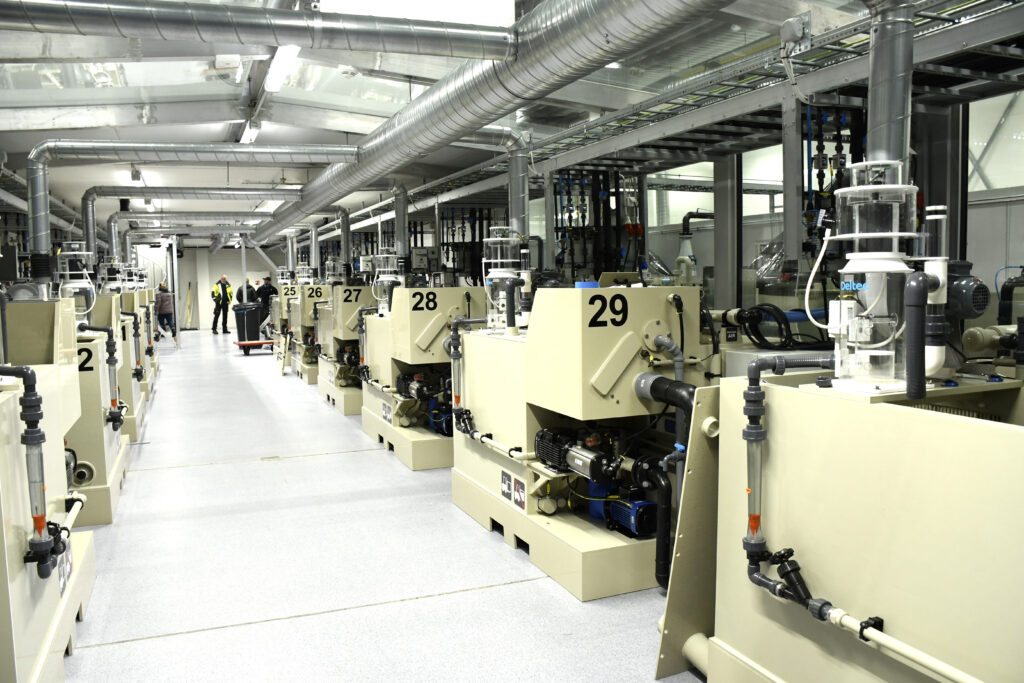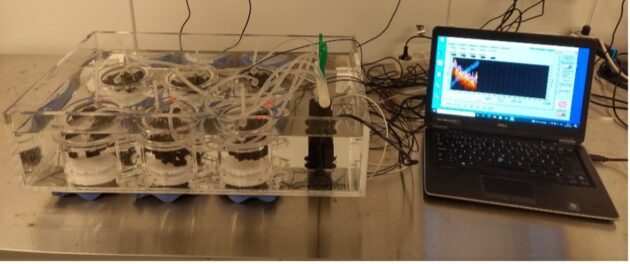
Features
Technology
Water Quality Week
Monitoring RAS biofilter performance: Nofima study
Is it possible to use oxygen to monitor the biofilters in a RAS system? Yes - with good results.
February 28, 2023 By Wanhe Qi, Technical University of Denmark
 (Photo: RAS Forsk, Nofima)
(Photo: RAS Forsk, Nofima) Results of a new study show a robust method with oxygen sensor to estimate the biofilter performance in freshwater recirculating aquaculture systems (RAS). The method is based on the use of oxygen sensor to monitor oxygen consumption rates of biofilter elements.
RAS are an indoor aquaculture system and operated under controlled environmental conditions. Water in RAS is recycled and reused after a series of water treatment processes with mechanical and biological filtration, disinfection, oxygenation and degassing. With the advantages of high-degree water reuse (>90 per cent of the culture water), reduced waste discharge and shorter transport distances to the markets, RAS are regarded as an environmentally sustainable system for fish production.
In RAS, biofilter is a fundamental water treatment unit and plays an important role in maintaining sufficient water quality for fish growth with the help of biofilm. Biofilm is defined as the aggregates of microorganisms that are attached on the surface of biofilter elements. Microorganisms need carbohydrates, fats, proteins, metals, and vitamins to survive, just like fish. By taking advantage of the features of microorganisms, the undesirable nutrients in RAS water for fish, such as ammonia and nitrite, can be removed or converted into their non-toxic form by biofilm.
Hence, biofilter performance is an important parameter for monitoring, operating, diagnosing and managing biofilter. It is generally evaluated based on ammonia or nitrite concentration decrease rates, which are obtained through feeding known concentration of ammonia or nitrite to the sampled biofilter elements.
For instance, to get information of biofilter performance in terms of ammonia removal, the bio-elements collected from RAS biofilter were placed in a batch reactor following ammonia spike. Then, the reduction of ammonia in the batch reactor over time reflects the ammonia removal performance of biofilter. However, this method is time-consuming and laboratory equipment required. It seems unsuitable for on-site application in a RAS facility.
Instead, both processes are oxygen-consuming processes. That means they require oxygen for reactions in the ammonia and nitrite removal pathways and for respiration. By means of this, biofilter performance in RAS might be also assessed through monitoring the oxygen consumption following ammonia or nitrite spike.
In their study, researchers developed a custom-made platform equipped with oxygen sensor, which allows high throughput, non-invasive oxygen measurement without disturbing biofilm integrity. The method was tested with three different commercially available bio-elements from moving bed biofilm reactors in a common freshwater RAS, and is compared to the general method for biofilter performance assessment.

Fig. 1. Developed platform equipped with oxygen sensor for biofilter performance assessment (Photo: Nofima)
Results showed the biofilter performance evaluation with oxygen sensor was in satisfactory accordance with the values from substrate degradation batch kinetic tests for all three tested bioelements, confirming the feasibility and robustness of the developed method as a means to assessing biofilter performance.
The developed method can potentially be used to quantify the impacts of relevant biotic and abiotic conditions on biofilter performance in RAS, such as salinity changes, disinfection, increased feed loading, altered flow, etc. Furthermore, the proof-of-concept platform proposed can be miniaturized to reduce the sample volume and be easy to carry, which shows promising prospect for lab analysis and industrial application.
The study was carried out by researchers at the section for aquaculture, DTU Aqua, Technical University of Denmark in the RASHealth project, led by the Norwegian research institute Nofima. The work was funded by the Research Council of Norway, Young Research Talent Program. The application of this method is being validated at Nofima RAS facilities in Tromsø in collaboration with Nofima researchers. More results are expected in 2023.
More information of the study can be found in the peer-reviewed Aquaculture journal. The study was titled “Estimation of nitrifying and heterotrophic bacterial activity in biofilm formed on RAS biofilter carriers by respirometry” and published in December 2022.
 Wanhe Qi, is a Ph.D. student at The Technical University of Denmark, DTU Aqua. His Ph.D. project, “Bacterial activity in biofilm from RAS”, is part of the RASHealth project, led by the Norwegian food research institute Nofima.
Wanhe Qi, is a Ph.D. student at The Technical University of Denmark, DTU Aqua. His Ph.D. project, “Bacterial activity in biofilm from RAS”, is part of the RASHealth project, led by the Norwegian food research institute Nofima.
Print this page